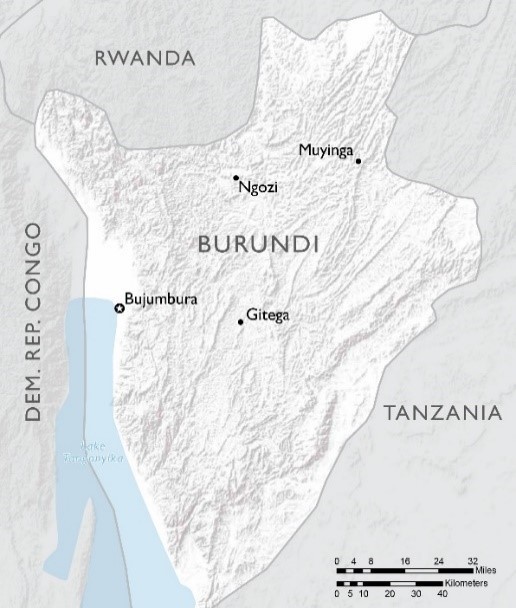Home » What We Do » Agriculture and Food Security » Food Assistance » Country Fact Sheets » Food Assistance Fact Sheet - Burundi
- What We Do
- Agriculture and Food Security
- Democracy, Human Rights and Governance
- Economic Growth and Trade
- Education
- Ending Extreme Poverty
- Environment and Global Climate Change
- Gender Equality and Women's Empowerment
- Global Health
- Water and Sanitation
- Working in Crises and Conflict
- U.S. Global Development Lab

October 12, 2017
Situation
- Ongoing political unrest in Burundi has displaced hundreds of thousands of people, both within the country and into neighboring countries, including Tanzania, Rwanda, the Democratic Republic of the Congo (DRC) and Uganda. As of October 2017, more than 408,000 Burundians have fled as refugees, while roughly 61,000 refugees from DRC were hosted in Burundi as of April, according to the Office of the UN High Commissioner for Refugees (UNHCR). The International Organization for Migration estimated in September that approximately 188,000 Burundians were internally displaced. The UN World Food Program (WFP) reports that nearly 4,000 Burundian refugees have returned from Tanzania since August, with up to 12,000 refugees expected to return by the end of 2017.
- An unstable economic situation continues to undermine food security in Burundi. According to the USAID-funded Famine Early Warning Systems Network (FEWS NET), frequent fuel shortages are increasing transportation costs and limiting the movement of food and goods into areas where they are needed. Furthermore, high staple food prices and limited livelihood opportunities diminish households’ access to food.
- Most poor households in Burundi will face Stressed (IPC 2) levels of food insecurity until January 2018, with food stocks declining and food prices rising during the September-to-December lean season, FEWS NET reports. Despite above-average June-to-August harvests in the majority of the country, localized production shortfalls in Bubanza and Cibitoke provinces may push some poor households into Crisis (IPC Phase 3) levels of food insecurity in October and November.
* The Integrated Phase Classification (IPC) is a standardized tool that aims to classify the severity and magnitude of food insecurity. The IPC scale, which is comparable across countries, ranges from Minimal (IPC I) to Famine (IPC 5).
Response
- With support from USAID’s Office of Food for Peace (FFP), WFP targets more than 1.4 million food-insecure individuals—including vulnerable, food-insecure Burundians and Congolese refugees—in Cankuzo, Kirundo, Bujumbura Rural, Ngozi, Rutana and Gitega provinces with emergency food assistance, including general food distributions, food vouchers, food-for-assets activities and targeted supplementary feeding for children under age 2 and pregnant and lactating women.
- FFP support also enables the UN Children’s Fund (UNICEF) to provide ready-to-use therapeutic food to treat severe acute malnutrition in children under age 5. In addition, FFP is partnering with UNICEF to conduct a nutrition survey in collaboration with the Government of Burundi to identify the specific areas most affected by acute malnutrition.
- In Muyinga Province, FFP supports a development program led by Catholic Relief Services (CRS) that aims to improve the nutritional status of children. CRS seeks to prevent chronic malnutrition in children under age 5, strengthen community-level systems for health and nutrition, foster positive behavior change and increase regular access to nutritious food.
Food for Peace Contributions
Total Contributions:
| U.S. Dollars | Metric Tons | |
|---|---|---|
| Fiscal Year 2017 | $21.1 million | 16,374 MT |
| Fiscal Year 2016 | $17.8 million | 6,942 MT |
| Fiscal Year 2015 | $23.7 million | 6,590 MT |
Country Specific Guidance:
- USAID Office of Food for Peace: Food Security Country Framework for Burundi FY 2014-2019 (PDF, 1 MB)
-
References for USAID FFP Food Security Country Framework for Burundi (PDF, 591 KB)
- Engender Burundi Sexual Violence Assessment Final Report (PDF, 585 KB)
- 2008 Burundi Population Survey: Household and Housing (PDF, 960 KB)
- 2008 Burundi Population Survey: Mortality (PDF, 5 MB)
- 2008 Burundi Population Survey: Poverty (PDF, 1 MB)
Additional Resources from FY 2010:







Comment
Make a general inquiry or suggest an improvement.